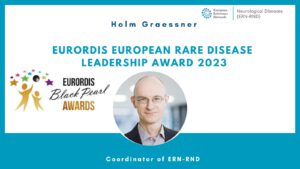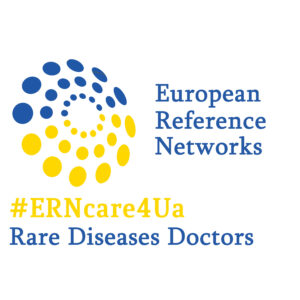The registration for the EAN 2023 just opened.
Find more infos on the EAN website:
Congress: 9th Congress of the European Academy of Neurology – Budapest 2023 – ean.org
Registration open: Register – ean.org

ERN-RND | European Reference Network on Rare Neurological Diseases
for rare or low prevalence complex diseases
The registration for the EAN 2023 just opened.
Find more infos on the EAN website:
Congress: 9th Congress of the European Academy of Neurology – Budapest 2023 – ean.org
Registration open: Register – ean.org
This is really a great honour, not just for me but for my team and the people I collaborate with. The dominating feeling is appreciation and gratefulness to the people I am privileged to work with in the area of rare diseases. And there are many nice and fit persons I collaborate with.
This is how Holm Graessner describes his surprise and joy about the award.
Since 2012, EURORDIS-Rare Diseases Europe has organized the Black Pearl Awards. Goal of the event is to recognise the major achievements and outstanding commitment of patient advocates, patient organisations, policymakers, scientists, companies, and media who strive to make a difference for the rare disease community.

Holm studied Biomedical Engineering, Cybernetics, German Language and Literature, Philosophy, Business Administration and Marketing. He obtained a PhD (summa cum laude, 2004) and an MBA (2008). Holm is a founding member of the first Centre for Rare Diseases in Germany (2010). The center established an umbrella infrastructure (chaired by Holm), a therapy research centre and a clinical information centre for rare diseases.
I am a healthcare manager and a research manager. As healthcare manager I am the managing director of the Centre for Rare Diseases at the University Hospital Tübingen and the coordinator of the European Reference Network for Rare Neurological Diseases. As research manager, my team and I have been coordinating more than 30 large global, European and national collaborative research projects.
Holm initiated and coordinates the European Reference Network for rare neurological diseases (ERN-RND) as well as “Solve-RD – solving the unsolved rare diseases”.
Joining forces with the European Academy of Neurology (EAN), he is a fellow of the EAN and member of the management team of the coordinating panel for rare neurological diseases and of the neurogenetics panel.
Finally, Holm is one of the driving forces of the Ataxia Global Initiative and the European Network “1 Mutation 1 Medicine”.
The motivation and the will to advocate for patients with rare diseases and to improve their situation is the drive of his work even after many years.
Effective collaboration in the field of rare diseases needs to be patient-driven. So it always starts with listening to and involving patients and patient representatives. Furthermore, effective collaboration needs shared goals, appropriate resources, leadership, good communication and an engaged team. In the (academic) rare disease field, collaboration very often implies self-exploitation, at least to a certain extent. So I tend to apply the “nice people rule”. Collaborate with nice people in order to keep motivation and joy levels high.
Read Holms portrait on the EURORDIS homepage: https://www.eurordis.org/black-pearl-2023-education-and-collaboration/
Call for Proposals 2023
“Natural History Studies addressing unmet needs in Rare Diseases”
The European Joint Programme on Rare Diseases (EJP RD) has successfully implemented four Joint Transnational Calls since 2019 to further help in coordinating the research efforts of European, Associated and non-European countries in the field of rare diseases and implement the objectives of the International Rare Disease Research Consortium (IRDiRC). These actions are following the ten Joint Transnational Calls for rare diseases research projects launched previously by the ERA-Net E-Rare since 2006.
The aim of the call is to enable scientists in different countries to build an effective collaboration on a common interdisciplinary research project based on complementarities and sharing of expertise, with expected impact to use the results in the future for benefit of patients.
Topic: Natural History studies addressing unmet needs in Rare Diseases
The objective of this call is to conduct efficient, innovative and high-quality natural history studies which will facilitate understanding of the disease’s or group of disorders’ progression throughout the lifespan of a patient. The goal of these studies is to collect and analyze comprehensive patient data to define targets for future therapies, taking into consideration innovation, safety, and efficacy.
Find more information here: https://www.ejprarediseases.org/joint-transnational-call-2023/
Presenting your research at Europe’s largest neurology forum has always been exciting, and this year will be even more so. A chance for us to meet in person and your opportunity to address an audience hungry for scientific meetings!
Whether you wish to present your work as an oral platform presentation, an ePoster or as a virtual ePoster format, this is the ideal time to share your latest study results with our enthusiastic neurology community.
Important points to remember:
Find more information here
In their new monthly podcast, Rare on Air, Communications Manager, Julien Poulain, meets with people who live with a rare disease, those who advocate for them, and experts on rare disease policy.
The podcast explores the unique experiences, challenges and successes of people from our community, and investigates how we can build a better world for those who have a rare condition.
Each episode focuses on a specific theme or policy area relating to the work and advocacy of EURORDIS.
Read more
Rare Disease Day is the official international awareness-raising campaign for rare diseases which takes place on the last day of February each year.
The main objective of the campaign is to raise awareness amongst the general public and decision-makers about rare diseases and their impact on patients’ lives. Rare Disease Day was launched by EURORDIS-Rare Diseases Europe and its Council of National Alliances in 2008.
Find more information about Rare Disease Day here.
Photo submissions for the Photo Award 2023 are open, until 22nd January 2023.
The EURORDIS Photo Award is an opportunity to visually express what it means to live with a rare disease and to share your story with the rare disease community and beyond.
The contest is open to all nationalities, ages and diseases. Every year hundreds of people from all around the world submit their photos, each reflecting the drive of people living with a rare disease worldwide.
Participate and submit your photo here.
Article: Recognizing early MRI signs (or their absence) is crucial in diagnosing metachromatic leukodystrophy
Authors: Daphne H. Schoenmakers, Shanice Beerepoot, Ingeborg Krägeloh-Mann, Saskia Elgün, Benjamin Bender, Marjo S. van der Knaap, Nicole I. Wolf, Samuel Groeschel
Published: November 2022
Rare diseases, including rare cancers, are a heterogeneous group of largely incurable, complex conditions. There are over 6000 rare diseases, and more than 70% have a genetic origin. Although individually characterised by low prevalence, the sheer number of rare diseases results in a directly affected community of 20 million people across the EU. Rare diseases are chronic, progressive, degenerative, disabling and frequently life threatening. They are typically accompanied by a scarcity of knowledge and expertise.
The Czech Presidency of the EU Council organised the Expert Conference on Rare Diseases in Prague on 25-26 October 2022 to explore how the European Union can take continued steps towards a coordinated strategy for rare diseases to better addresses current unmet needs by setting meaningful goals for patients, families and for society at large, integrated at the national and regional levels.
Find more information here.
For two days, experienced, as well as young academics and the representatives of patient organizations, exchanged views on existing initiatives and the improvement of research in the field of Childhood Epilepsy and Movement Disorders.
Rare neurologic disorders in pediatrics often go unrecognized, resulting in protracted delays in diagnosis and limited treatment options. Even when detected early, treatment remains mostly empiric, due in part to limitations in clinical trial design and implementation: several of these disorders with similar clinical manifestations are caused by a variety of affected genes, while therapy in one group of patients may not be applicable to all individuals with the same genetic defect. The main objective of this networking event was to bring together clinicians and scientists from different EU countries and other countries who are intensively involved in clinical research and/or basic research in the field of epilepsy and movement disorders. The event explored the possibility of new treatment approaches in light of recent developments in the field. Researchers were given the opportunity to establish new collaborations, discuss the development of precision medicine hypotheses, and conduct treatment trials to reach more patients across Europe.
Authors:
Published: October 2022
From September 29th to October 1st the annual meeting took place at the CRONA-Kliniken in Tübingen. We are happy that besides the online participants also many on-site participants were present. We would like to thank all participants again for the inspiring presentations, discussions and the valuable exchange.
Astri Arnesen, ERN-RND ePAG representative and president of the European Huntington Association, participated in Tübingen and says:
In my opinion this network will be an important part of providing expertise and best practise treatment and support to RND patients all over Europe.
Read the full article here
In a new leaflet in our section disease knowledge we answer the questions what a recessive ataxia is, which symptoms indicate Friedreich`s ataxia and which forms of treatment are available.
EURORDIS – Rare Diseases Europe developed a short guide to explain in simple and practical terms how to involve patients and patient representatives in the development of clinical practice guidelines and consensus statements.
You may download the guide here.

The 24 European Reference Networks (ERNs) for rare and complex diseases are united to support all Ukrainian patients.
This application connects patients from Ukraine with a rare disease with organizations and hospitals, members of the European Reference Network (ERN), with the aim to provide the specialized medical support they may need during this emergency.
